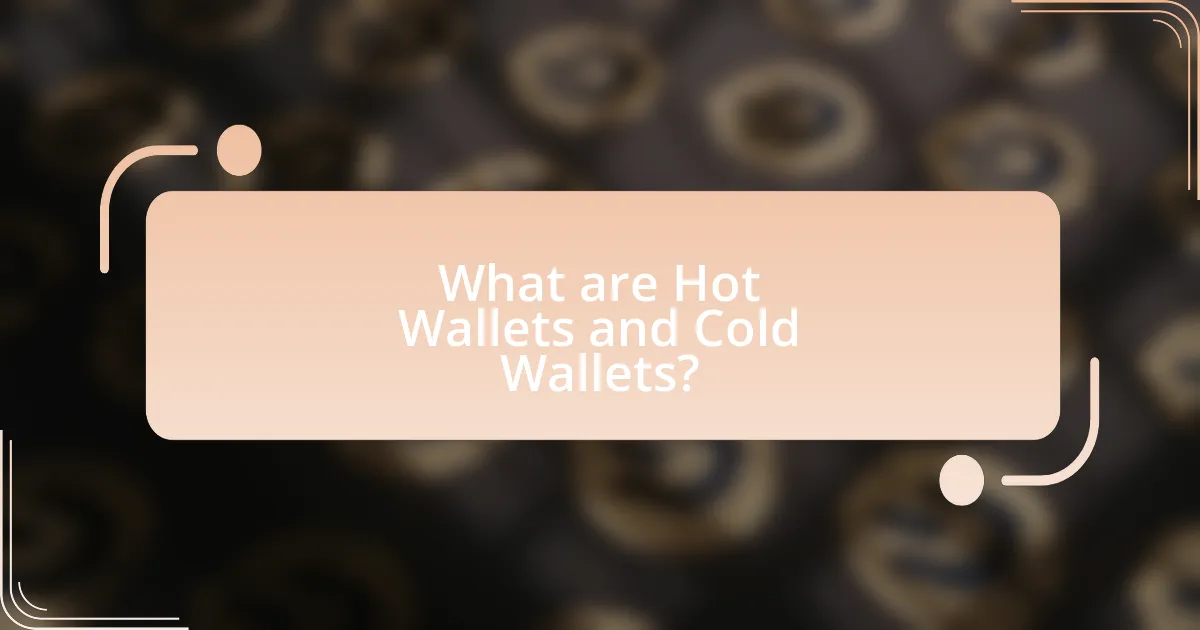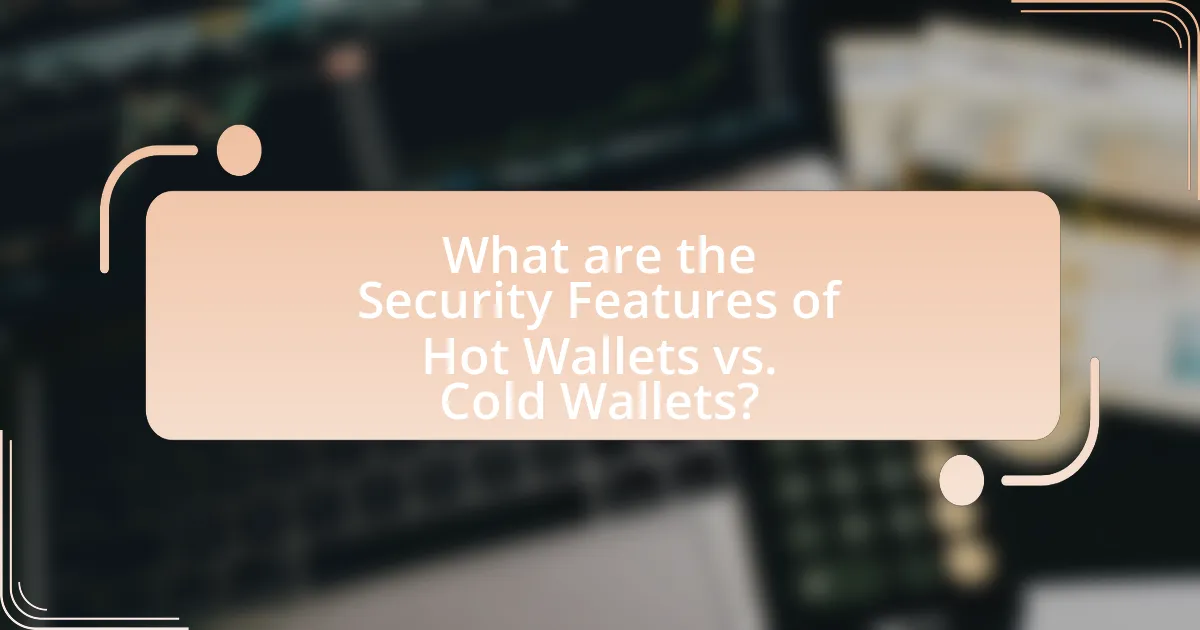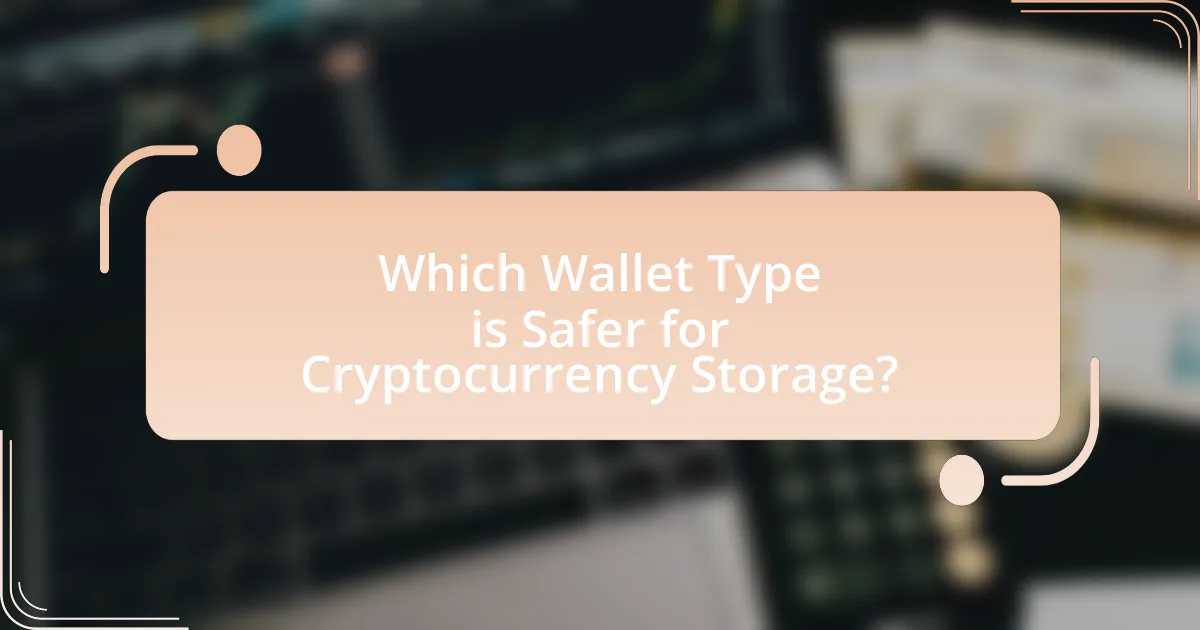The article focuses on comparing hot wallets and cold wallets in the context of cryptocurrency storage, examining their functionalities, security features, and associated risks. Hot wallets, which are internet-connected and facilitate quick transactions, offer convenience but are more susceptible to hacking and cyber threats. In contrast, cold wallets provide offline storage solutions that enhance security by keeping private keys away from the internet, making them safer for long-term asset storage. The article also discusses the types of each wallet, security measures, and best practices for users to effectively manage their cryptocurrency security.

What are Hot Wallets and Cold Wallets?
Hot wallets are digital wallets that are connected to the internet, allowing for quick and easy access to cryptocurrencies for transactions. They are typically used for everyday transactions due to their convenience but are more vulnerable to hacking and cyber attacks. Cold wallets, on the other hand, are offline storage solutions for cryptocurrencies, such as hardware wallets or paper wallets, which provide enhanced security by keeping private keys away from the internet. This offline nature significantly reduces the risk of unauthorized access, making cold wallets a safer option for long-term storage of digital assets.
How do Hot Wallets function in cryptocurrency storage?
Hot wallets function in cryptocurrency storage by providing a digital interface for users to store, send, and receive cryptocurrencies while being connected to the internet. These wallets facilitate quick transactions and easy access to funds, making them ideal for frequent trading or everyday use. However, their online connectivity exposes them to potential security risks, such as hacking or phishing attacks, which can lead to the loss of funds. The convenience of hot wallets is balanced by the need for users to implement additional security measures, such as two-factor authentication, to mitigate these risks.
What are the key features of Hot Wallets?
Hot wallets are digital wallets that are connected to the internet, allowing for quick and easy access to cryptocurrencies. Key features include high accessibility, enabling users to send and receive funds instantly; user-friendly interfaces, which simplify transactions for individuals; and integration with exchanges, facilitating trading activities. Additionally, hot wallets often support multiple cryptocurrencies, providing versatility for users. However, their connection to the internet makes them more vulnerable to hacking and security breaches, underscoring the importance of using them with caution.
What types of Hot Wallets are available?
There are several types of hot wallets available, including web wallets, mobile wallets, and desktop wallets. Web wallets are accessible through internet browsers and allow users to manage their cryptocurrencies online. Mobile wallets are applications installed on smartphones, providing convenient access to digital assets on the go. Desktop wallets are software programs downloaded to personal computers, offering a higher level of security compared to web wallets while still being connected to the internet. Each type of hot wallet serves different user needs, balancing convenience and security.
How do Cold Wallets function in cryptocurrency storage?
Cold wallets function in cryptocurrency storage by keeping private keys offline, thereby enhancing security against hacking and unauthorized access. These wallets, which include hardware wallets and paper wallets, store the user’s cryptocurrency information in a manner that is not connected to the internet. This offline status significantly reduces the risk of cyber attacks, as the keys cannot be accessed remotely. For example, hardware wallets like Ledger and Trezor utilize secure elements to protect private keys, ensuring that even if the device is connected to a compromised computer, the keys remain safe. This method of storage is widely regarded as one of the safest options for holding cryptocurrencies, particularly for long-term investments.
What are the key features of Cold Wallets?
Cold wallets are secure storage solutions for cryptocurrencies that are not connected to the internet, making them less vulnerable to hacking. Key features include enhanced security due to offline storage, which protects against online threats; the ability to store multiple types of cryptocurrencies; and user control over private keys, ensuring that users maintain ownership of their assets. Additionally, cold wallets often come in the form of hardware devices or paper wallets, providing physical means of safeguarding digital assets. These features collectively contribute to the overall safety and integrity of cryptocurrency holdings.
What types of Cold Wallets are available?
There are several types of cold wallets available, including hardware wallets, paper wallets, and USB drives. Hardware wallets, such as Ledger and Trezor, store private keys offline and provide a secure way to manage cryptocurrencies. Paper wallets involve printing the private and public keys on paper, ensuring they are not stored digitally. USB drives can also be used to store wallet files offline, providing another layer of security against online threats. Each type of cold wallet offers distinct advantages in terms of security and accessibility for cryptocurrency storage.

What are the Security Features of Hot Wallets vs. Cold Wallets?
Hot wallets are connected to the internet and offer convenience for transactions, but they are more vulnerable to hacking and cyber attacks due to their online nature. In contrast, cold wallets are offline storage solutions, providing enhanced security against unauthorized access and cyber threats, making them significantly safer for long-term asset storage. The risk associated with hot wallets is evidenced by numerous high-profile hacks, such as the 2016 Bitfinex hack, where approximately $72 million was stolen, highlighting their susceptibility. Cold wallets, such as hardware wallets, are designed to store private keys offline, which minimizes exposure to online threats and has been proven effective, as seen in the absence of successful hacks targeting cold storage solutions.
What security risks are associated with Hot Wallets?
Hot wallets are associated with several security risks, primarily due to their constant connection to the internet. This connectivity makes them vulnerable to hacking, phishing attacks, and malware, which can lead to unauthorized access and theft of funds. For instance, in 2020, the KuCoin exchange suffered a hack that resulted in the loss of over $280 million from its hot wallets, highlighting the significant risk posed by online storage solutions. Additionally, hot wallets are susceptible to user error, such as accidentally sharing private keys or falling for scams, further increasing the likelihood of financial loss.
How do online threats impact Hot Wallet security?
Online threats significantly compromise Hot Wallet security by exposing them to various cyberattacks, such as phishing, malware, and hacking attempts. Hot Wallets, which are connected to the internet, are particularly vulnerable because they store private keys online, making them accessible to malicious actors. For instance, a 2021 report by Chainalysis indicated that over $7.7 billion in cryptocurrency was stolen through hacks, with a substantial portion targeting Hot Wallets. This data underscores the heightened risk associated with online threats, which can lead to unauthorized access and loss of funds.
What measures can be taken to enhance Hot Wallet security?
To enhance Hot Wallet security, users should implement multi-factor authentication (MFA), regularly update software, and utilize strong, unique passwords. MFA adds an additional layer of security by requiring more than one form of verification, significantly reducing the risk of unauthorized access. Regular software updates ensure that the wallet is protected against known vulnerabilities, as cyber threats evolve rapidly. Strong, unique passwords prevent easy guessing or brute-force attacks, as studies show that weak passwords are a common entry point for hackers. Additionally, users should avoid accessing their Hot Wallets over public Wi-Fi networks, as these connections can be insecure and expose sensitive information.
What security risks are associated with Cold Wallets?
Cold wallets, while generally considered secure, face specific security risks including physical theft, loss, and damage. Physical theft can occur if the cold wallet is not stored securely, making it vulnerable to being stolen. Loss can happen if the user misplaces the device or forgets the recovery phrase, resulting in permanent loss of access to the stored assets. Damage risks arise from environmental factors, such as fire or water, which can render the wallet unusable. According to a report by the Blockchain Research Institute, 20% of Bitcoin users have lost access to their wallets due to these risks, highlighting the importance of secure storage and backup practices.
How do physical threats impact Cold Wallet security?
Physical threats significantly compromise Cold Wallet security by exposing the hardware to risks such as theft, damage, or unauthorized access. For instance, if a cold wallet is physically stolen, the thief can gain direct access to the stored cryptocurrency, especially if the wallet is not protected by a strong PIN or encryption. Additionally, environmental factors like fire or water damage can render the wallet inoperable, leading to potential loss of funds. According to a report by the Blockchain Research Institute, physical security measures are crucial, as 90% of cryptocurrency thefts occur through physical means, highlighting the importance of safeguarding cold wallets against tangible threats.
What measures can be taken to enhance Cold Wallet security?
To enhance Cold Wallet security, users should implement multiple layers of protection, including using hardware wallets, enabling strong PINs or passwords, and regularly updating firmware. Hardware wallets, such as Ledger or Trezor, store private keys offline, significantly reducing the risk of online attacks. Strong PINs or passwords add an additional barrier against unauthorized access, while firmware updates ensure that the wallet is protected against newly discovered vulnerabilities. According to a report by the Blockchain Security Alliance, hardware wallets are considered one of the safest methods for storing cryptocurrencies due to their offline nature and robust security features.

Which Wallet Type is Safer for Cryptocurrency Storage?
Cold wallets are safer for cryptocurrency storage compared to hot wallets. Cold wallets, which include hardware wallets and paper wallets, store cryptocurrencies offline, significantly reducing the risk of hacking and online theft. In contrast, hot wallets are connected to the internet, making them more vulnerable to cyber attacks. According to a report by Chainalysis, 70% of cryptocurrency thefts occur from hot wallets, highlighting their inherent risks. Therefore, for secure storage, cold wallets are the preferred option.
What factors should be considered when comparing safety?
When comparing safety, key factors include the level of security against hacking, the storage method of private keys, and the frequency of access. Hot wallets, which are connected to the internet, are more vulnerable to cyber attacks, while cold wallets, which store keys offline, provide enhanced security. According to a report by the Blockchain Security Company, 80% of cryptocurrency thefts occur from hot wallets due to their online exposure. Additionally, the user experience and backup options also play a crucial role in safety, as users must ensure they can recover their assets in case of loss or theft.
How does user behavior influence wallet safety?
User behavior significantly influences wallet safety by determining how securely individuals manage their private keys and access credentials. For instance, users who employ strong, unique passwords and enable two-factor authentication reduce the risk of unauthorized access to their wallets. Conversely, users who engage in risky behaviors, such as sharing their private keys or using public Wi-Fi for transactions, increase the likelihood of theft or loss. Research indicates that 81% of data breaches are due to weak passwords, highlighting the critical role user behavior plays in maintaining wallet security.
What role does wallet accessibility play in security?
Wallet accessibility significantly impacts security by determining how easily users can access their funds and manage their assets. High accessibility, as seen in hot wallets, allows for quick transactions but increases vulnerability to hacking and phishing attacks, with reports indicating that over 70% of cryptocurrency thefts occur from hot wallets. Conversely, cold wallets, which are less accessible, provide enhanced security by storing assets offline, reducing exposure to online threats. This trade-off between accessibility and security is crucial for users to consider when choosing a wallet type, as the level of accessibility directly correlates with the potential risk of unauthorized access.
What are the best practices for securing both Hot and Cold Wallets?
The best practices for securing both hot and cold wallets include using strong, unique passwords, enabling two-factor authentication (2FA), and regularly updating software. Strong passwords protect against unauthorized access, while 2FA adds an additional layer of security by requiring a second form of verification. Regular software updates ensure that wallets are protected against known vulnerabilities.
For cold wallets, it is crucial to store them in a secure physical location, such as a safe, and to create backups of the wallet’s recovery phrases or private keys in multiple secure locations. This minimizes the risk of loss due to theft or damage.
In the case of hot wallets, users should avoid accessing them over public Wi-Fi networks and should consider using a virtual private network (VPN) for added security. These practices help mitigate risks associated with online threats and unauthorized access.
How can users effectively manage their cryptocurrency security?
Users can effectively manage their cryptocurrency security by utilizing a combination of cold wallets for long-term storage and hot wallets for active trading. Cold wallets, such as hardware wallets, store cryptocurrencies offline, significantly reducing the risk of hacking, as they are not connected to the internet. In contrast, hot wallets, while more convenient for transactions, are vulnerable to online threats. According to a report by Chainalysis, over $1.9 billion was stolen from hot wallets in 2020 alone, highlighting the importance of using cold storage for significant holdings. Additionally, users should implement strong passwords, enable two-factor authentication, and regularly update their software to further enhance security.
What common mistakes should be avoided in wallet security?
Common mistakes to avoid in wallet security include using weak passwords, failing to enable two-factor authentication, and neglecting to keep software updated. Weak passwords can be easily guessed or cracked, making wallets vulnerable to unauthorized access. Two-factor authentication adds an extra layer of security, and its absence significantly increases the risk of theft. Additionally, outdated software may contain security vulnerabilities that can be exploited by attackers, leading to potential loss of funds. According to a report by the Cybersecurity & Infrastructure Security Agency, 80% of data breaches involve weak or stolen passwords, highlighting the importance of strong password practices in wallet security.